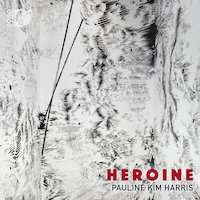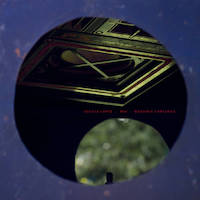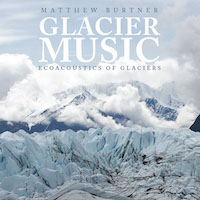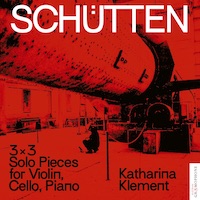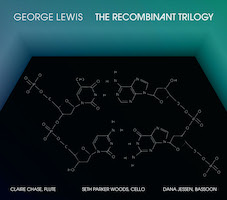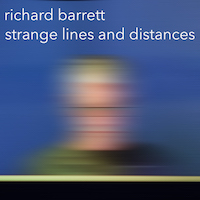EA Bucket 31: With Instruments
|
Grant Chu Covell [July 2021.]
“Heroine.” Pauline Kim HARRIS and Spencer TOPEL: Ambient Chaconne (2018-19); Deo (2018-19). Pauline Kim Harris (vln), Spencer Topel (electronics). Sono Luminus DSL-92235 (1 CD) (www.sonoluminus.com). The violin is duplicated and sublimated in these complimentary works for solo instrument and electronics. The first takes a slow-motion swing (42 minutes) through J.S. Bach’s Chaconne (BWV 1004) and the second at Johannes Ockeghem’s Deo Gratias. Coolly establishing a reflective mood, Chaconne splinters flit across slow pedals and gentle synth blips, perhaps a classy background to a distilled spirit commercial or that moment when intrepid explorers decipher ancient scrolls in a modern library. Deo builds from Ockeghem’s four canons (the original 36 voices required nine voices per part). The violin starts the tune and the electronics nudge the results onto a perpetually ascending escalator until nothing remains but starry resonance. The effect is lovely, but perhaps obvious.
Cecilia LOPEZ: “Desastres civiles,” “Por elevación,” “PP,” “Larga distancia,” and “Sin Bateria” from Red (2017)1; Machinic Fantasies (2018)2. Jean Carla Rodea2, Julia Santoli2 (performers, spinners), Christopher McIntyre2 (trpt), Joe Moffett2 (trb), Cecilia Lopez1,2 (electronics). XI Records XI 140 (2 CDs) (www.xirecords.org). These are tense recordings of site-specific electroacoustic performances which may not equate to having been in New York City in October 2017 or in Brooklyn in May 2018 respectively, but they are better than nothing. The notes are a two-sided sheet with six panels on each side that folds nicely into the shape of a standard booklet. Four writers (Kurt Gottschalk, Rebecca Bengal, John Driscoll, Carmen Baliero) credentialize and explain Lopez’ work, referring to other performances and Lopez’ aesthetic. There are photos of each performance, and a miniature score (or plan) for Machinic Fantasies occupies two panels. Red was a large installation, a floor-to-rafters cherry-red net with contact microphones and speakers, that could elicit the humming and spitting of controlled feedback. Machinic Fantasies is somewhat similar in effect, except large rotating oil drums with microphones and cameras can control sound and visuals, and a trumpet and trombone contribute loose held tones as if we are in a gigantic tolling bell. Red aligns with the genre that Tudor initiated; Machinic Fantasies spins elsewhere. These aren’t really situations where music is played, but rather where discovered sounds are shaped and coaxed. Even via a finite recording which the home listener can start or stop at will there is the sense the low rumble or gentle whirr could erupt irrepressibly.
“Glacier Music: Ecoacoustics of Glaciers.” Matthew BURTNER: Sound Cast of Matanuska Glacier (2015-19)1; Sonic Physiography of a Time-Stretched Glacier (2014)2; Threnody (Sikuigvik) (2015)3; Syntax of Snow (2011)4; Muir Glacier, 1889-2009 (2019)5. Rivanna Quartet1: Daniel Sender, David Sariti (vln), Ayn Balija (vla), Adam Carter (vlc), Albemarle Ensemble1: Kelly Sulick (fl), Shawn Earle (clar), Katy Ambrose (hrn), Greg Howard (Chapman Stick), Brandon Bell2, Trevor Saint4 (perc). Ravello Records RR8001 (1 CD) (www.ravellorecords.com). The last time I encountered Burtner’s music, I wished for something longer and Burtner delivers with “Glacier Music.” These pieces combine the sounds of glaciers, flowing water, and melting ice and snow in contemplative ways. Sound Cast of Matanuska Glacier adds a doleful string quartet, flute, clarinet, horn and Chapman Stick (like an electric guitar, but longer and with more strings) to the sound of dripping water, essentially the Matanuska Glacier (Alaska). Sonic Physiography of a Time-Stretched Glacier adds metallic percussion to the slowed sound of a glacier melting (Root Glacier, Alaska). The percussionist’s playing can control the playback rate, essentially simulating the suspension of global warming. Syntax of Snow combines the bright sounds of glockenspiel with struck snow. That is, a percussionist plays both pitched instrument and snow. The struck snow sounds like muffled scratching or rubbing, presumably the mallet’s attack is absorbed by the ice crystals. Purely electronic, Threnody (Sikuigvik) leverages sounds from the Aialik Glacier (Alaska). At under five minutes, it was meant for a gallery installation and was broadcast from an ice block. The light popping sounds are actually air bubbles being released from melting ice. Muir Glacier, 1889-2009 was also meant for an installation. This half-hour accompanies Thomas Hill’s 1889 painting of the Muir Glacier, which by 2009 had retreated significantly, essentially out of visible sight from the painting’s original vantage point. To the gentle sounds of moving water, Burtner adds light electronic washes, “sonifications” of the glacier’s physical retreat. I have firsthand experience of observing the Mendenhall Glacier in Alaska retreat. On my first visit in 2004, I recall the glacier being visible from the visitor station and intruding into the lake. In 2016, my second visit, the glacier was barely visible having shrunk backwards up into the valley.
“Schütten.” Katharina KLEMENT: Schütten (2018). Tiziana Bertoncici, Barbara Lüneberg, Annelie Gahl (vln), Audrey Chen, Séverine Ballon, Michael Moser (vlc), Georg Graewe, Oskar Aichinger, Thomas Lehn (pno). Austrian Gramophone AG0018 (1 CD) (www.austriangramophone.com). In German, “schütten” is the verb for pouring and dumping, actions relating to cement manufacturing. These pieces are Klement’s consideration of construction materials, cement specifically. Cement is a material which progresses from powder to liquid to solid in combination with water and temperature. In these pieces Klement considers this chemical transformation, as well as sounds made by machines involved in the preparation of raw materials. No, this is not musique concrète. For one set of solo pieces the players are asked to respond to the site recordings and improvise. For another set, the players realize graphic scores derived from the field recordings. For a third set, the players work with Klement’s traditionally notated transcription of the field recordings. The nine pieces open onto different expressive tableaux; perhaps inevitably, the results are brash and spiky, rich in non-standard sounds and harmonics (on the strings and piano interior). The pianos explore repetition and have a jazzier feel. Recorded closely, the nine solos are interleaved with nine field recordings from the Zementwerk Mannersdorf. Do the scraping bows and animated harmonics sound like a factory? No they don’t, but a listener will think differently about construction and creation, and about where artistic impulses sit in music as well as material science.
“The Recombinant Trilogy.” George LEWIS: Emergent (2014)1; Not Alone (2014-15)2; Seismologic (2017)3. Claire Chase1 (fl), Dana Jessen3 (bsn), Seth Parker Woods2 (vlc and electronics), Levy Lorenzo1, Eli Stine3 (electronics). New Focus Recordings FCR284 (1 CD) (www.newfocusrecordings.com). Instruments plus real-time electronic transformation have been with us for years. But Lewis has found new things to say. Leveraging software written by Damon Holzborn (using Max), flute, cello and bassoon flitter and convulse within three works for instrument plus “recombinant” electronics. We hear all variety of delays, transformations and spatialization effects. The players’ raw materials can be abrupt wriggles, scratches or torn gestures. The essential nature of the instrumentalist’s material is novel and the transformations inventive: changes in pitch, timbre, motion through the sound stage, etc. The flute can be smooth or vulgar and the cello traverses its full range with non-standard bowing. The bassoon work is the most unexpected (there are fewer works for bassoon and electronics generally), as the processing conjures up the sounds of sea birds, buzzing insects, and frolicking elephants. Comparisons with the natural world may not have been Lewis’ aim. These three pieces can be explored separately or considered as a trilogy.
“Strange Lines and Distances.” Richard BARRETT: strange lines and distances (2011)a; Vermillion Sands (2017-18); luminous (2019)b; eye-blink (1) (2020)c; disquiet (2018). Siân Wassermanna,b (voice), Alinéa Ensemblec: Tyler Bouque (voice), Emma Burge (vln), Robbie Bui (vlc), Matthew Henson (cbs), Jack Yarbrough (pno), Alex Garde (perc). STRANGE STRINGS str02 (1 digital album) (richardbarrett.bandcamp.com). The cleverness of Barrett’s program does not become evident until the final startling piece. Each work is longer than the next, and while the five are not sequenced chronologically, the weight of the 26-minute electroacoustic disquiet brings everything together. These pieces reveal Barrett using texts and instruments with electronics to create interesting situations, and it is disquiet’s single-minded boldness which suggests that this is where the composer would like to live. Strange lines and distances and luminous leverage the voice of the composer’s daughter, speaking texts (Francis Bacon’s The New Atlantis and Georg Trakl’s De Profundis) which are essentially unintelligible and transformed so that we must accept that the words meant something to the composer. Vermillion Sands has no audible texts or voice, but indicates an eponymous group of stories by J.G. Ballard where decaying sculptures emit disturbing sounds. The texts in eye-blink (1) can be more intelligible, but given they are responses and “re-readings” of Tang dynasty poems, we are still denied explicit communication. eye-blink (1) involved remote collaboration with the musicians during the 2020 pandemic. Music and recordings were sent back and forth, and Barrett fashioned this fixed media piece (which will eventually include live performers). Disquiet uses software that emulates the Arp 2600, recreating the rowdy beauty of the analog synthesizer, however, tightly controlled and layered as is possible with digital technology. The sounds of Barrett’s other pieces, i.e. strange lines and distances, are clean and bubbly as we might expect from processed speech and today’s computers, and so the rough textures are even more surprising but ever absorbing.
[More EA Bucket, Grant Chu Covell]
[Previous Article:
String Theory 36: Predominantly Quartets]
[Next Article:
Used Bin Troll Tweets ZZ.]
|
